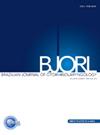序贯皮瓣重建头颈癌:系统回顾
IF 1.8
4区 医学
Q2 OTORHINOLARYNGOLOGY
引用次数: 0
摘要
目的头颈部肿瘤(HNC)患者皮瓣重建是头颈部大面积缺损的治疗方式之一。虽然大多数患者通过单个皮瓣获得满意的结果,但由于各种原因,有些患者可能需要第二次或额外的皮瓣。本研究的目的是系统地回顾相关文献,探讨顺序皮瓣在HNC患者重建中的应用。方法两名作者独立筛选PubMed、EBSCO和Web of Science的文章。如果研究报告了以下至少一项结果:手术或住院时间、皮瓣相关术后并发症、皮瓣成功率和随访结果,则纳入研究。结果共纳入17篇文献,包括832例患者和1037个皮瓣(不包括首次重建使用的皮瓣数量)。皮瓣整体失败率为5.4%。在314例皮瓣相关术后并发症中,最常见的是翻修(5.8%)、皮瓣完全坏死(5.2%)和动脉或静脉血栓形成(3.3%)。结论序贯皮瓣是HNC患者可选择的、有效的修复方式。然而,需要前瞻性研究来探索与预后相关的危险因素,并更好地确定顺序皮瓣对个体患者的适用性。此外,由于重建会影响美观和功能,在术前讨论时强调术后结果可能不完全符合患者的期望是至关重要的。本文章由计算机程序翻译,如有差异,请以英文原文为准。
Sequential flaps reconstruction in head and neck cancer: A systematic review
Objectives
For patients with Head and Neck Cancer (HNC), flap reconstruction is one of the treatment modalities for large head and neck defects. While most patients achieve satisfactory outcomes with a single flap, some may require a second or additional flaps due to various reasons. The aim of our study was to systematically review the relevant articles and investigate the application of sequential flaps in reconstruction of patients with HNC.
Methods
Two authors independently screened articles from PubMed, EBSCO, and Web of Science. Studies were included if they reported at least one of the following outcomes: duration of operation or hospitalization, flap-related postoperative complications, flap success rate, and follow-up outcomes.
Results
A total of 17 articles were included, comprising 832 patients and 1037 flaps (excluding the number of flaps used in initial reconstructions). The overall flap failure rate was 5.4%. Among the 314 flap-related postoperative complications, the most common were revision (5.8%), complete flap necrosis (5.2%), and arterial or venous thrombosis (3.3%).
Conclusion
Sequential flaps are an optional and effective reconstructive modality for HNC patients. However, prospective studies are needed to explore prognostic-related risk factors and better determine the suitability of sequential flaps for individual patients. Additionally, since reconstruction impacts both aesthetics and function, it is crucial to emphasize during preoperative discussions that postoperative outcomes may not fully align with patient expectations.
求助全文
通过发布文献求助,成功后即可免费获取论文全文。
去求助
来源期刊

Brazilian Journal of Otorhinolaryngology
OTORHINOLARYNGOLOGY-
CiteScore
3.00
自引率
0.00%
发文量
205
审稿时长
4-8 weeks
期刊介绍:
Brazilian Journal of Otorhinolaryngology publishes original contributions in otolaryngology and the associated areas (cranio-maxillo-facial surgery and phoniatrics). The aim of this journal is the national and international divulgation of the scientific production interesting to the otolaryngology, as well as the discussion, in editorials, of subjects of scientific, academic and professional relevance.
The Brazilian Journal of Otorhinolaryngology is born from the Revista Brasileira de Otorrinolaringologia, of which it is the English version, created and indexed by MEDLINE in 2005. It is the official scientific publication of the Brazilian Association of Otolaryngology and Cervicofacial Surgery. Its abbreviated title is Braz J Otorhinolaryngol., which should be used in bibliographies, footnotes and bibliographical references and strips.
 求助内容:
求助内容: 应助结果提醒方式:
应助结果提醒方式:


